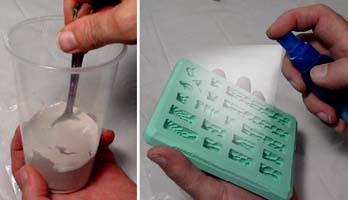
Prevent adhesion to the gypsum cement plaster cast.Ģ. Separators Satisfactory separation agents must provide the following functions:ġ. Sand the pattern or model and apply several coats of a clear lacquer. After wood filler has set overnight, apply a coat of a clear acrylic sealer and allow to dry.

Apply a heavy coat of Hydroperm gypsum plaster and let it dull down then wipe off excess by rubbing across the grain. A paste wood filler can be used to fill the grain of the wood, but should be reduced to a satisfactory brushing consistency with the recommended thinner. Mahogany patterns or models require special treatment because gypsum cement plaster casts may adhere to undercuts caused by multiple pores or grain of the wood. Apply second coat after first coat has thoroughly dried.Where a plaster or gypsum cement pattern is used, apply lacquer immediately after set. Correct procedure is to reduce lacquer with lacquer thinner so that the model or pattern readily absorbs the first coat.

Two coats of lacquer provide more resistance to moisture than shellac. Patterns of metal, glass, plastic and other impervious materials normally do not require sealing.Ī quick-drying lacquer applied by brush or spray gun is an excellent sealer for wood, plaster and gypsum-cement patternsĪnd master models. Gypsum cement plaster patterns also require sealing to prevent them from absorbing water from the plaster mix and causing the mix to adhere to the gypsum cement pattern. Sealing is particularly essential for wood patterns to prevent dampness from causing the wood to swell, resulting in release difficulty. It “sets up.” Porous model materials require sealing prior to application of the parting compound.Īll porous models, patterns and molds must be sealed before the parting agent is applied. They also permit removal of plaster or gypsum cement from the surface of the pattern or model upon which Parting compounds (also called “separators” or “releasers”) are needed to prevent adhesion of plaster or gypsum cement to For producing permeable plaster molds for precision casting of many nonferrous metals and alloys. The amount of water and time of mixing will change the physical properties.HYDROPERM gypsum plaster is a specially formulated product incorporating an air entraining agent to provide permeability. This product is a unique gypsum cement designed to produce a highly porous mold media for the casting of many non-ferrous metal and alloys. It is frequently used as the basic ingredient in dental stone, investment casting plasters and floor underlayment compounds. Its high strength makes this general purpose gypsum cement a versatile performer. Designed for use in investment casting, dental and medical industries.įor tooling applications where setting expansion is not a critical factor, Denscal WH gypsum plaster is an ideal choice. Generally, the castings are sand blasted or buffed for a smoother finish.Ī base Denscal gypsum cement, this low-consistency product provides moderate to low expansion. Then the individual castings are removed from the cluster and subjected to further processing such as heat treatment or grinding.

Once the precision castings are cooled, they can be cleaned using high-pressure water, vibratory or shot blast methods. Molten metal is then poured into the ceramic cavities left by the dewaxed pattern. Then the wax pattern is removed from the ceramic shell by firing it in a oven.

These injection molds are then encased in multiple layers of ceramic material partly composed of a specialty plaster like Denscal® IC. Generally, the process entails making an injection-molded wax pattern for each part produced. Such materials include low- to high-carbon alloy steel, stainless steel, tool steel aluminum and brass as well as nickel and cobalt base alloys are also used. The industrialization of this process was made feasible by the development of new, inorganic, high-temperature ceramic mold binders to process applications that include high strength and corrosion resistant materials. This process became common in industrial processing during World War II, when there was a demand for rapidly finished parts and "near net-shape" components requiring complex, often thin-wall castings, that could readily be put into final form.


 0 kommentar(er)
0 kommentar(er)
